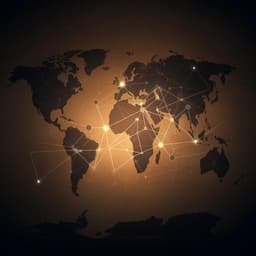
Environmental Studies and Forestry
Mapping global lake dynamics reveals the emerging roles of small lakes
X. Pi, Q. Luo, et al.
Discover how lakes, the vital natural resources and unexpected carbon gas emitters, have transformed over four decades globally, with insights from a team of researchers including Xuehui Pi and Yang Xu. Uncover the surprising role of small lakes in influencing water variability and carbon emissions.
~3 min • Beginner • English
Introduction
Lakes are central to global hydrological and biogeochemical cycles and provide critical ecosystem services, yet rapid changes in lake areas are occurring worldwide due to climate change and human activities. Desiccation from water withdrawals and droughts has caused water shortages and conflicts in some regions, while glacier- and snowmelt-driven expansions have occurred elsewhere. Despite the availability of frequent, global satellite observations, distinguishing lakes from rivers is challenging because of similar optical signals. Existing global lake datasets have largely been based on snapshots and have not fully accounted for seasonal and interannual fluctuations, with an emphasis on medium to large lakes. Small lakes (<1 km^2) are highly dynamic, sensitive to natural variability and human management, and disproportionately influence primary productivity, biodiversity, and the carbon cycle. However, uncertainties in the distribution and size of small lakes have limited global assessments, and lake size changes over time have not been characterized globally. This study aims to close that gap by mapping more than 3.4 million lakes and reservoirs >0.03 km^2 globally using deep learning to separate lakes from rivers and to detect lakes smaller than previous minimum mapping units. We quantify decadal changes in lake areas over four decades and assess implications for lacustrine carbon emissions.
Literature Review
Prior efforts estimated global lake extents using compilations and snapshot imagery (e.g., GLWD, HydroLAKES), often without incorporating seasonal/interannual variability and with size limits typically >0.1 km^2. Scaling approaches (e.g., Pareto distributions) and inventories based on single epochs (e.g., circa-2000 GLOWABO) have provided alternative estimates but may overestimate small lakes or conflate lakes with rivers. Studies have documented global surface water changes but could not separate lake versus river contributions. Work on lake dynamics has focused on larger lakes with well-defined boundaries, leaving small, more variable lakes underrepresented. Small lakes have been shown to contribute disproportionately to primary productivity, biodiversity, and greenhouse gas emissions, with size-dependent CO2/CH4 fluxes. Recent studies reported widespread growth of glacial lakes and changes in endorheic basin storage, and highlighted anthropogenic influences (e.g., reservoirs) on surface water variability. These gaps and findings motivated a globally consistent, high-resolution, multi-decadal lake mapping to isolate lake-specific dynamics, especially for small lakes, and to refine global carbon emission estimates.
Methodology
Data sources: The study used the Global Surface Water Occurrence (GSWO) dataset (30 m Landsat, 1984–2019; 60°S–80°N) to characterize water presence probabilities. Auxiliary datasets included RGI 6.0 and IMBIE for glacier distributions, NASA NSIDC permafrost coverage, HydroBASINS for endorheic basins, GeoDAR for reservoirs, and GPW v3/v4 for population density. Deep-learning mapping: A modified U-Net semantic segmentation approach was trained to distinguish lakes (lentic waters) from rivers (lotic waters) using GSWO images. Lake labels were created by automated extraction and manual editing combining GSWO, GRWL (rivers), OSM Water Layer (oceans/rivers), and HydroLAKES polygons, with occurrence thresholds (5% generally; 30% in floodplains) and manual correction in hydrologically complex regions. The minimum mapped lake area was set to 0.03 km^2 (~33 Landsat pixels). Two models were trained: a Normal Model and a Floodplain Model, each on stratified samples representing distinct hydrologic patterns (e.g., high/low occurrence lakes, large lakes, adjacent-to-river lakes, floodplain clusters). Training used 512×512-pixel patches with local normalization; model selection was based on validation loss and MIoU. Postprocessing: Predictions were mosaicked globally, with OSMWL and GRWL masks reapplied to remove oceans and rivers. Coastal intersections with oceans were removed using buffers and manual edits. Residual rivers were minimized by excluding polygons with area ratios <0.8 after river masking (unless overlapping HydroLAKES), with additional manual corrections in large basins. Outputs from Normal and Floodplain models were combined using river-buffer zones flagged as floodplain (based on seasonal flooding proportion >0.1) to select the appropriate model’s lakes. Mapping outputs (GLAKES) include all lakes/reservoirs >0.03 km^2 and were partitioned into small (<1 km^2), medium (1–100 km^2), and large (>100 km^2). Accuracy: Independent test sets yielded overall area accuracies >98.7% and MIoU >88.7%. Omission errors were higher for small lakes (≈21–24%), with smaller commission errors; mapped extents are conservative. Lake dynamics: Probability-weighted lake area within GLAKES boundaries was computed per period: 1984–1999 (1980–1990s), 2000–2009 (2000s), 2010–2019 (2010s). Water occurrence per pixel was N/N0 from GSW monthly water history. Areas were aggregated to 1°×1° grids; cells with insufficient observations (fewer than 30, 20, and 20 valid observations for the three periods) were excluded. Lakes intersecting buffers around glaciers and permafrost grids identified glacial/permafrost-fed lakes; GeoDAR distinguished reservoirs; HydroBASINS Endo flagged endorheic basins. Variability attribution: Within each grid, the contribution of small lakes to variability was defined as ΔAsmall/(ΔAsmall+ΔAmedium+large) using absolute area changes. Carbon emissions: Following Holgerson & Raymond (2016), lakes were binned into seven logarithmic size classes. Size-dependent mean (and bounds) of CO2/CH4 fluxes were multiplied by total lake area (all-time maximum) to estimate global emissions; the same method with probability-weighted areas estimated per-period emissions and net changes over decades.
Key Findings
- Global mapping: GLAKES delineated 3.4 million lakes/reservoirs >0.03 km^2 globally. Total all-time maximum lake area is ~3.2×10^6 km^2 (2.2% of land). North of 60°N holds 49.8% of lakes by count and 23.6% by area. By size: small (<1 km^2) = 94.39% of count and 15% of area; medium (1–100 km^2) = 5.56% of count and 26% of area; large (>100 km^2) = 0.05% of count and 59% of area. Including lakes <0.1 km^2 (1.91 million) increases small-lake bounded area by 30.2% compared to HydroLAKES. - Decadal changes: From 1984–1999 to 2000s, net lake area increased by +39,784 km^2. Glacial/permafrost-fed systems (30% of global lake area) contributed 48% (+19,104 km^2) of the increase; 52% (+20,681 km^2) was mostly due to reservoir expansion outside cryospheric regions. Declines occurred in western USA, central Asia, northern China, and southern Australia, aligned with droughts and water stress. From 2000s to 2010s, the net area gain was only 16.3% of the prior decade’s increase, dominated by reservoirs (+8802 km^2) versus natural lake increases in cryospheric regions (+3362 km^2). Large lakes showed a net decrease of −14,553 km^2, ~50% from Aral Sea shrinkage. Over 1984–1999 to 2010s, global net increase totaled +46,278 km^2 (~1.8× Lake Erie; ≈ size of Denmark), with 56% attributed to reservoirs. Continuous expansions and shrinkages occurred in 38% and 9% of inland lake regions, respectively. - Role of small lakes: Small lakes exhibit higher temporal variability (median relative areal change +2.9% from 1984–1999 to 2000s; +0.6% from 2000s to 2010s; significantly greater than medium/large, P<0.05). 8.6% and 6.8% of small lakes more than doubled in the two successive periods. Small lakes contributed 46.2% of the net global areal increase (1984–1999 to 2010s) and dominated variability (>50% of absolute area change) in ~50% of 1°×1° inland grid cells across both transitions. Variability generally increased with population density and was higher for small lakes, indicating human influence. - Carbon emissions: Updated global lacustrine emissions estimated at 226 Tg C yr−1 (CO2) and 1.4 Tg C yr−1 (CH4), smaller than earlier estimates due to more accurate lake areas, especially fewer small-lake areas than previously assumed. Small lakes contribute disproportionately: 25% of CO2 and 37% of CH4 emissions while comprising only 15% of area. Over time, net increases from 1984–1999 to 2010s were +4.81 Tg C yr−1 (CO2) and +0.03 Tg C yr−1 (CH4); small lakes accounted for 45% and 59% of these increases, respectively.
Discussion
The GLAKES dataset substantially improves upon previous global lake inventories by providing consistent, high-resolution (~30 m), multi-decadal coverage and explicit separation of lakes from rivers, enabling robust assessment of lake dynamics and their drivers. Results show that while climate-driven expansions in glacial and permafrost regions are notable, human-regulated reservoirs contributed more than half of the global net lake area increase over four decades, underscoring the dominant role of anthropogenic alterations in global surface water dynamics. The identified net loss within endorheic basins aligns with GRACE-based storage declines; however, when excluding the Aral Sea, small lakes in endorheic regions have expanded, revealing heterogeneity masked in coarse assessments. Small lakes, despite their modest area share, disproportionately drive variability in inland water extent and carbon emissions, often in regions with higher human pressures, highlighting their sensitivity to management and local climate. Updated CO2 and CH4 emission estimates, grounded in more accurate lake areas, are lower than some prior global upscalings but still emphasize the outsized role of small lakes. These findings directly address the research questions by quantifying the spatially explicit, size-dependent dynamics of lakes, disentangling natural versus anthropogenic contributions, and linking surface area changes to changes in greenhouse gas emissions.
Conclusion
This study delivers a globally consistent map of 3.4 million lakes (>0.03 km^2) and their decadal dynamics, revealing a net global lake area increase of ~46,278 km^2 since the mid-1980s, driven predominantly (56%) by reservoirs. Small lakes, though only 15% of total area, disproportionately govern variability in lake extent and contribute substantially to both the level and the increase of lacustrine CO2 and CH4 emissions. The GLAKES dataset provides a foundation for improved assessments of hydrologic budgets, flood risk, aquatic biodiversity, and biogeochemical cycling. Future work should (1) refine separation of lakes from agricultural and wetland waters, (2) better account for seasonality, ice cover, vegetation masking, and very small waterbodies, (3) integrate evolving eutrophication and temperature effects into emission upscaling, and (4) incorporate process-based models and more extensive in situ measurements to constrain size-dependent fluxes and temporal variability. Management and monitoring efforts should prioritize small lakes due to their outsized ecological and climatic roles.
Limitations
Uncertainties arise from: (1) Lake definition and inclusion of some tidal flats, wetlands, or agricultural fields; potential omission of seasonally ice-covered or heavily vegetated small/shallow lakes; (2) Dependence on auxiliary datasets (e.g., GRWL/OSM river masks, glacier/permafrost maps) that may be incomplete regionally; (3) U-Net model limitations, including higher omission errors for small lakes and lower performance for very large/coastal waterbodies; (4) Postprocessing choices (e.g., masking thresholds, buffer definitions) that can exclude or include marginal cases; (5) Probability-weighted area comparisons can be influenced by seasonal dynamics and uneven observation density across periods; (6) Carbon emission estimates rely on literature mean size-dependent fluxes that may not capture spatiotemporal variability, eutrophication trends, temperature effects, or all CH4 pathways (e.g., ebullition), making temporal change estimates conservative.
Related Publications
Explore these studies to deepen your understanding of the subject.







